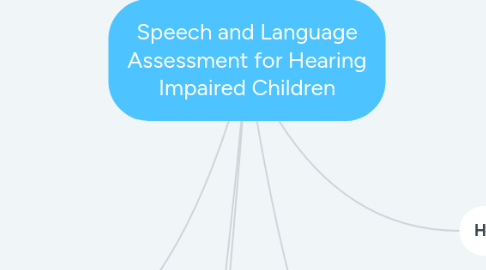
1. Speech Assessment
1.1. Voice and Fluency
1.1.1. resonance
1.1.1.1. rhinolalia
1.1.2. airflow
1.2. Oral-Facial Examination (special considerations)
1.2.1. control of verbal instructions (the instructions need to be very clear)
1.2.2. integrity of the oral-facial mechanism
1.2.3. velopharyngeal mechanism
1.3. Articulation and Phonology
1.3.1. stimulability
1.3.2. connected speech
1.3.3. speech-sound inventory
1.3.3.1. familiar words
1.3.4. contextualized
2. Language Assessment
2.1. Comprehension
2.1.1. Semantics
2.1.1.1. receptive repertoire
2.1.1.2. vocabulary
2.1.2. Syntax
2.1.2.1. types of sentences
2.1.2.1.1. Interrogative
2.1.2.1.2. Imperative
2.1.2.1.3. Declarative
2.1.2.1.4. Compound
2.1.2.1.5. Complex
2.1.2.1.6. simple
2.1.3. Morphology
2.1.3.1. Gender-bounding morphemes
2.1.3.2. Subject-verb agreement
2.1.3.3. singular/plural
2.1.4. Pragmatics (focus on)
2.1.4.1. level of understanding of abstract concepts
2.1.4.2. different types of play
2.1.4.3. non-verbal communication
2.2. Production
2.2.1. Semantics
2.2.2. Pragmatics
2.2.3. Syntax
2.2.4. Morphology
2.3. Prerequisites for oral language assessment: with the hearing impaired infant, gestural emphasis has to be taken into consideration
2.3.1. eye-contact
2.3.2. Joint-attention
2.3.3. play
2.3.4. turn-taking
2.3.5. communication intentions
2.3.6. object permanence
2.3.7. imitation
3. Mode of Communication
3.1. Monolingual/bilingual
3.1.1. mono-lingual
3.1.1.1. sign language
3.1.1.1.1. speech and language assessment measures will have to be modified accordingly
3.1.1.2. oral language
3.1.2. bilingual
3.1.2.1. sign and oral language
3.2. Sign Language
3.2.1. proficiency
3.2.2. the reliance on this mode
3.3. AAC system
4. Standardized testing
4.1. there are certain formal testing tools that are developed for the hearing impaired population: those can provide us with certain normative scales that we can refer to.
4.1.1. not enough on its own
5. Patient's Presentation
5.1. name, age, class, school,
5.2. medical information
5.2.1. associated condition
5.2.2. Family history
5.2.3. Treatments/surgeries (CI)
5.2.3.1. Age of fitting
5.2.3.1.1. prelingual
5.2.3.1.2. perilingual
5.2.3.1.3. postlingual
5.2.4. Audiogram/Audiologist's input (with special emphasis on residual hearing)
5.3. previous therapies
5.3.1. speech therapy (most importantly)
5.3.2. occupational therapy
5.3.3. psychomotor therapy
6. Hearing Assessment
6.1. previously done
6.1.1. carefully go over assessment results
6.2. not previously done
6.2.1. administer a comprehensive hearing assessment which covers
6.2.1.1. auditory detection
6.2.1.2. auditory discrimination
6.2.1.3. auditory identification
6.2.1.4. auditory comprehension
6.2.1.5. NB: all subsequent assessment measures must take into consideration the hearing assessment results
